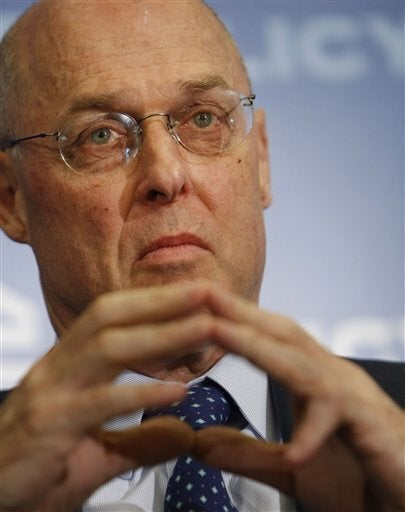
Decisions made during the final months of the Bush administration created an environment in which the most politically connected investment banks, Goldman Sachs and Morgan Stanley, not only flourished, but saw their competitors laid waste, with firms like Lehman in bankruptcy, and others, like Merrill Lynch and Bank of America, forced to merge in desperate hope of surviving.
Two recent news stories raise some interesting questions about Goldman Sachs. In the opaque world of investment banking and federal regulation, these reports shed light on the difficulty of determining where to draw the line between routine complex financial transactions and problematic conflict of interest and favoritism.
The first story ran on the cover of last weekend's Barron's: "Resurrection on Wall Street" (subscription required). It documents in some detail the success of Goldman Sachs and Morgan Stanley as "Wall Street's sole standouts." The highly favorable story, which only peripherally refers to the government support each institution has received, concludes that they are both "making attempts to adapt to the new financial realities. Combined with the decline of their competitors, that makes them good bets for investors now." For a couple of banks trying to boost their stock, what more could you ask for?
The second story, which was covered on March 15 by most news outlets, was based on the disclosure by the American International Group, Inc. (AIG) of massive payments to domestic and foreign financial institutions, and to 20 states, using money provided by U.S. taxpayers through the federal bailout. While most news stories focused on payments made to non-U.S. institutions, fueling populist anger, one of the more interesting aspects of AIG's disclosure statement is the fact that Goldman Sachs, at $12.6 billion, is the single largest beneficiary of AIG largess.
The roots of the linkage between Goldman Sachs and AIG go back to the closing months of the Bush administration, as the financial meltdown reached crisis proportions and key decisions were made that are now reaping the whirlwind. Remember who played a key role in deciding to bail out AIG? Henry Paulson, the Goldman CEO-turned George W. Bush Treasury Secretary. Paulson, according to a September 27, 2008 New York Times piece by Gretchen Morgenson, led a team of regulators and bankers in early September to determine what to do with the most severely wounded financial institutions.One of the participants in those meetings was Lloyd C. Blankfein, Paulson's successor at Goldman Sachs.
Out of those meetings came the controversial and heavily criticized decision to allowLehman Brothers, a Goldman competitor, to go belly up, and to bail out AIG. Starting with $85 billion from the Fed, taxpayers have pumped a total of $170 billion into the giant insurance company. The bailout was crucial to Goldman in that it permitted AIG to pay off its $12.6 billion debt to the firm, $8.1 billion of which was to cover AIG-backed credit derivatives.
At a hearing of the House Financial Services Committee on February 11, 2009, Goldman Sachs CEO Lloyd Blankfein denied that his firm had a major stake in bailing out AIG. Blankfein told the panel that "with respect to our dealings with AIG, we were always fully collateralized and had de minimis or no credit risk at any given moment because we exchanged collateral....We had transactions with them. And if they had gone the wrong way, they would have owed us money. We assumed they'd pay it, but if they defaulted, they wouldn't pay us. We insured against that default. We didn't win money from it. We wouldn't have made money. But it would have protected our down side."
Throughout the past six months of economic crisis, Goldman has taken full advantage of what the government has to offer. On October 28, 2008, Goldman and eight other banks were the first to receive federal bailout money under the Treasury Department's Troubled Assets ReliefProgram (TARP). which was initiated by Paulson. On November 25, 2008, Goldman became the first bank in the nation to benefit from the Federal Deposit Insurance Corp.'s Temporary Liquidity Guarantee Program (TLGP), issuing $5 billion in government-secured debt at 3.367%, substantially less than the market rate facing banks which issued unsecured debt. All told, Goldman has issued a total of $20 billion in government-guaranteed debt under TLGP. In their dealings with banks, both Treasury and the Fed have been subject to relatively minimal disclosure, in order to protect the proprietary interests of financial institutions, especially to prevent rumors of illiquidity or excessive debt from threatening a bank's viability.
*
The banking and insurance industries have traditionally been among the most politically influential sectors. That was especially true during the George W. Bush years, when regulatory policies and tax legislation -- especially cuts in the rates on dividend and capital gains income -- produced a corporate bonanza. In the 2004 election, these financial interests demonstrated their gratitude by contributing hundreds of thousands to the Bush-Cheney '04 campaign. Employees of Morgan Stanley gave Bush more than any other company, $600,480; followed by Merrill Lynch, $580,004; PricewaterhouseCoopers, $513,750; UBS Americas, $472,075; Goldman Sachs, $390,600; MBNA Corp, $356,350; Credit Suisse Group, $331,040; Lehman Brothers, $329,725; Citigroup Inc, $320,620; and Bear Stearns, $309,150.
* *
The consequences of the decisions made in the private meetings chaired by Republican Treasury Secretary Hank Paulson back in September 2008, are just now coming to light, even if transparency is modest at best. Clearly, when regulators and the regulated are trusted to reach decisions behind closed doors -- decisions involving the financial viability of majorbanks -- those who are regulated, operating out of public view, will do all they can to insure that their interests are protected.